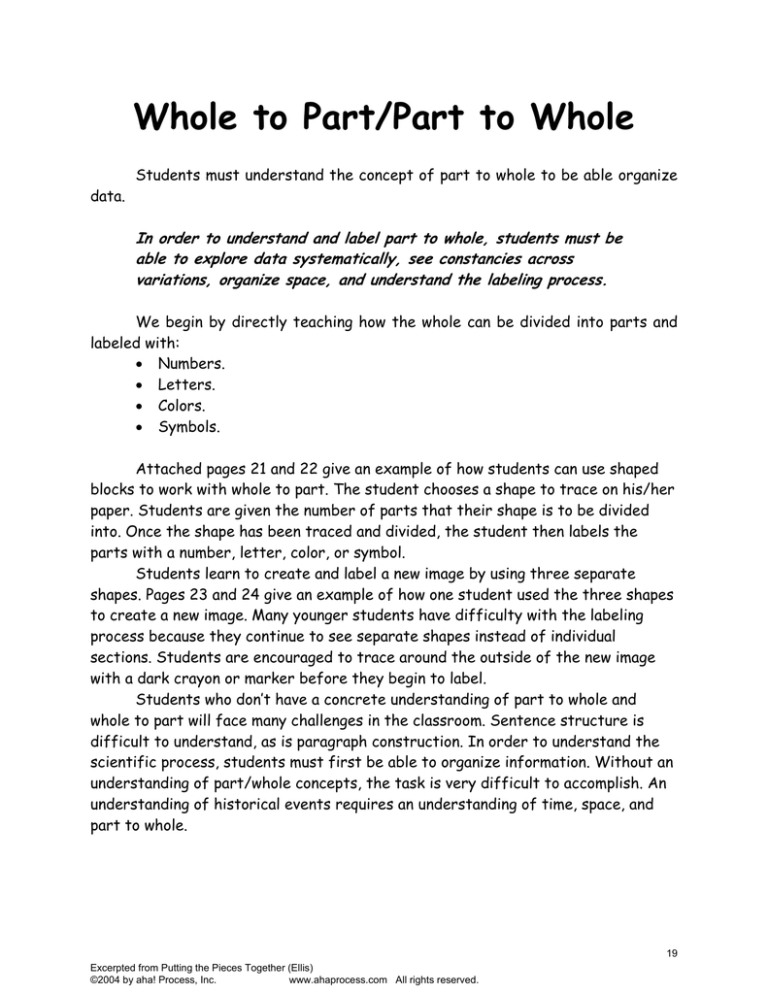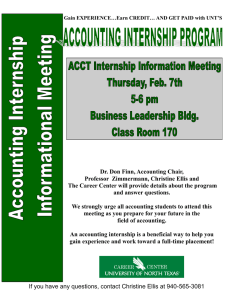
Whole to Part/Part to Whole
Students must understand the concept of part to whole to be able organize
data.
In order to understand and label part to whole, students must be
able to explore data systematically, see constancies across
variations, organize space, and understand the labeling process.
We begin by directly teaching how the whole can be divided into parts and
labeled with:
Numbers.
Letters.
Colors.
Symbols.
Attached pages 21 and 22 give an example of how students can use shaped
blocks to work with whole to part. The student chooses a shape to trace on his/her
paper. Students are given the number of parts that their shape is to be divided
into. Once the shape has been traced and divided, the student then labels the
parts with a number, letter, color, or symbol.
Students learn to create and label a new image by using three separate
shapes. Pages 23 and 24 give an example of how one student used the three shapes
to create a new image. Many younger students have difficulty with the labeling
process because they continue to see separate shapes instead of individual
sections. Students are encouraged to trace around the outside of the new image
with a dark crayon or marker before they begin to label.
Students who don’t have a concrete understanding of part to whole and
whole to part will face many challenges in the classroom. Sentence structure is
difficult to understand, as is paragraph construction. In order to understand the
scientific process, students must first be able to organize information. Without an
understanding of part/whole concepts, the task is very difficult to accomplish. An
understanding of historical events requires an understanding of time, space, and
part to whole.
19
Excerpted from Putting the Pieces Together (Ellis)
©2004 by aha! Process, Inc.
www.ahaprocess.com All rights reserved.
The following activities were used to help students create a mental model
for part to whole.
Purpose: To develop a mental model for whole to part and part to whole.
Materials: Pencil, wooden or plastic shape blocks and 19, 21, 24, 26, 28, 30.
Vocabulary: Corners, sides, intersection, point, segment, ray, part, whole.
Activity 1: Whole to Part, page 21
1. Students are asked to define what they see on the page.
How many segments?
How many corners?
How many points of intersection?
2. Students label the corners of each shape.
3. Read and label the directions.
4. Students label the final product.
Activity 2: Part to Whole, page 23
1. Students choose or are given three plastic or wooden shape pieces. Paper
examples at the bottom of the page can be used if plastic or wooden pieces are
not available.
2. Students create a new image using the three shapes.
3. The image is repeated in the second box.
4. Students label the image by numbering each section.
5. Students label the image by coloring each section.
20
Excerpted from Putting the Pieces Together (Ellis)
©2004 by aha! Process, Inc.
www.ahaprocess.com All rights reserved.
Whole to Part
Divide each shape into six sections.
Color each section a different color.
21
Excerpted from Putting the Pieces Together (Ellis)
©2004 by aha! Process, Inc.
www.ahaprocess.com All rights reserved.
Whole to
Whole
to Part
Part
Divide each shape into six sections.
Color each section a different color.
22
Excerpted from Putting the Pieces Together (Ellis)
©2004 by aha! Process, Inc.
www.ahaprocess.com All rights reserved.
Part to Whole
Using three shapes, create a new image in the
box below. Repeat the image in the second box.
After the new image is created, number each section differently.
After the new image is created, color each section a different color.
23
Excerpted from Putting the Pieces Together (Ellis)
©2004 by aha! Process, Inc.
www.ahaprocess.com All rights reserved.

